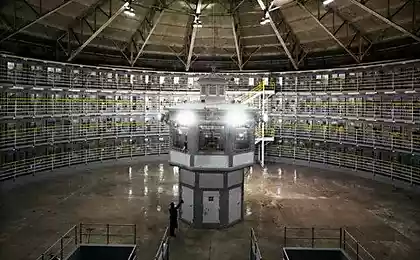1282
Top to beat the handy
One of the main objectives adopted in the early 1941 armored Il-2 was the fight against armored vehicles. This could be used for members of the armed cannon caliber 20-23-mm rockets caliber 82-132 mm and bombs weighing up to 600 kg.
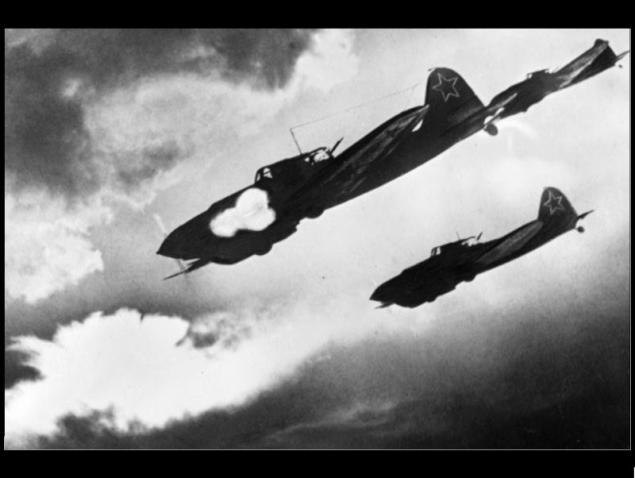
combat experience during the initial period of the Great Patriotic War showed sufficiently high combat effectiveness of IL-2, with actions to neukrytoy manpower, artillery and mortar positions, trains and convoys.

Mechanized columns of the Il-2 is usually attacked from strafing (altitude approach to the goal of 25-30 meters) along the column or at an angle of 15-20 degrees to its long side. The first blow was struck on the head of the column to suspend its movement. Opening fire range of 500-600 meters. Aiming carried out "in the column at all" with zeroing tracer bullets from machine guns ShKAS. Then, taking into account the position of the track bullets on the objective, opened fire with guns and PC. The effectiveness of on-board fire IL-2 on the objectives that constituted the column (infantry in cars, armored vehicles, artillery, etc.) was high enough.
However, available as part of airborne weapons 20mm cannons ShVAK and 23-mm load cells could only be tackled effectively with light tanks, armored personnel carriers and armored cars.
During the fighting, it became clear that the attack of the German light and medium tanks Il-2, armed with guns ShVAK, along the column completely ineffective because the frontal armor of German tanks had a thickness of 25-50 mm and a projectile gun ShVAK did not break.

Single Il-2 early series, armed with 20-mm cannon and ShVAK 7, 62 mm machine guns ShKAS
Field testing ShVAK gun when firing on captured German tanks carried out between June and 8 July 1942, showed that the armor-piercing shell ShVAK gun can penetrate the armor of chrome-molybdenum steel with high (up to 0, 41%) carbon thickness up to 15 mm (tank Pz .II Ausf F, Pz.38 (t) Ausf C, APC Sd Kfz 250) at angles close to the normal meeting with a distance of no more than 250-300 m. In the event of these conditions is the firing of cannons ShVAK become ineffective.
Thus, by increasing the angle between the projectile with the armor above 40 degrees obtained solid bounce even on sites armor thickness of 6-8 mm. For example, out of 19 results obtained with the shooting of this gun on BTR Sd Kfz 250 (height 400 m approach, glide angle of 30 degrees, the distance of opening fire 400 m), there were 6 of through holes in the board (the thickness of armor 8 mm), 4 - in the roof of the motor hood (thickness 6 mm armor), 3 rebound and 6 hits in the chassis. Hit in the same chassis armored significant lesions are usually not applied.

Destroyed German Sd Kfz 250 armored personnel carrier
Appearance at the front from August 41- th Il-2 with guns VYA- 23 caliber 23 mm although raised in general combat effectiveness assault air units, but not as much as would be desirable - the impact of the modified "sludge" against armored Wehrmacht remained low .
Armor-piercing incendiary projectile 23-mm cannons load cell at a distance of 200 meters past the normal 25-mm armor. IL-2, armed with guns QI-23, could defeat only a slight German tanks, and then only when the last attack from behind or from the side at an angle to the planning of 30 °. Attack as Il-2 of any German tank in front with both planning and a strafing was completely ineffective, and the average German tanks - also when attacking from behind.
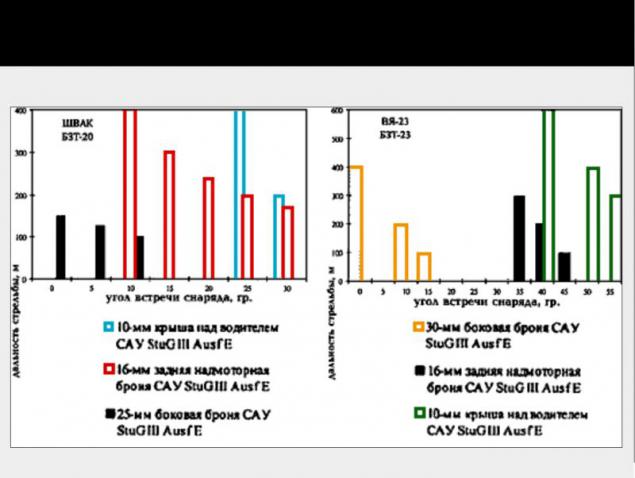
According to experienced pilots the most convenient and efficient shooting with IL-2 cannons QI-23 at German tanks, in terms of orientation, maneuvering, the time spent on the combat course, shooting accuracy and so is shooting with planning at an angle 25-30 ° at the input to the planning adjustment 500-700 m and a speed input 240-220 km / h (the height of O - 200-150 m). Gliding speed single IL-2 at these angles increased slightly - only 9-11 m / s, which made possible maneuvering for pickup by the sight and the track. Full Time Attack goal (elimination of side-slip at the turn of the target, aiming and firing of the guns) in this case was ample and varied from 6 to 9 seconds, which allowed the pilot to make two or three turns sights on the basis that to eliminate the side slip stormtrooper at the turn of the target must spend about 1 5/2 seconds, and aiming to fix crosstalk between bursts is also required 1, 5-2 sec, and the queue length is less than 1 s (firing cannons VYa more than 1-2 seconds led to a substantial crosstalk disturbance to a dramatic increase and dispersion of projectiles, i.e. a reduction in accuracy). Range start aiming at the tank is 600-800 m, and the minimum distance of opening fire - about 300-400 m.
In this case, managed to get hit a few shells into the tank. Keep in mind that not all shells in armor-piercing ammunition were. A meeting with the angle of the tank armor was often not optimal for penetration.
Accuracy of missiles RS-82 and RS-132 members of the armed IL-2 allows you to effectively engage area targets, but to fight with tanks, it was clearly insufficient.
Polygon firing rockets regular PC-82 and PC-132 conducted in NPC AB AFRA, as well as the experience of combat use of IL-2 on the front, showed little effectiveness of these weapons by the action of small targets because of the large dispersion of shells and, therefore, low probability of hitting the target.
The average percentage of hits in the RS-82 tank pickup point when shooting from a distance of 400-500 m, as shown in the materials of the report amounted to 1, 1%, and in a column of tanks - 3, 7%, with 186 issued shells were received only 7 direct hits. The height of the approach to the goal - 100 m and 400 m, the angles of planning - 5-10 ° and 30 ", respectively, the range of sight - 800 m. The shooting was carried out by single volley of shells and 2, 4 and 8 rounds.

Missiles RS-82
When firing revealed that the RS-82 can defeat the German light tank type Pz.II Ausf F, Pz.38 (t) Ausf C, as well as an armored car Sd Kfz 250 only when a direct hit.

MS-gap 82 in the vicinity of the tank (0, 5-1 m) no infection it is not harmful. The least probable deviation was obtained in a salvo of 4 RSov planning at an angle of 30 degrees.

RS-82 under the wing of the IL-2
Results firing PC-132 have been worse. Terms attacks were the same as in the RS-82 shooting, but the launch range - 500-600 m. The probable circular deviation range of PC-132 at angles planning IL-2 25-30 degrees approximately 1, 5 times higher than it was, than for the PC-82, and planning for the angles 5-10 degrees - almost coincided.
To destroy light and medium German tank shell PC-132 required only a direct hit, since the bursting shells near the tank, significant damage to the tank, as a rule, did not receive. However, to achieve a direct hit was very, very difficult - of the 134 shots PC-132 made in terms of range pilots with varying degrees of training, do not give any contact with the tank.
Especially for anti-tank aircraft were created with armor-piercing missiles warhead - RBS-82 and RBS-132. Which, in contact with normal punched 50-mm and 75-mm armor respectively. These shells have been created based on the RS-82 and RS-132. In addition to the new warhead, the shells had a more powerful engine, thereby increasing speed flight MS and the probability of hitting the target. As shown by field testing. RBS pierce tank armor and then exploded, causing severe damage inside the tank. RS armor have been successfully applied in the fighting in August 1941. However, mass production of them began only in the second half of the war. Despite the improved performance accuracy and armor penetration, missiles and did not become effective against tanks. Armor penetration is strongly dependent on the angle of the meeting with the armor, and the probability of hitting remained inadequate.
In the arsenal of IL-2, along with rockets RBS-132, had armor-piercing warhead, as a means of combating the German armored vehicles at this time firmly ingrained missile ROFS-132 with improved, compared with the RBS-132 or PC-132, accuracy of fire shooting. Warhead missile ROFS-132 provides through penetration (direct hit), medium armor of German tanks.
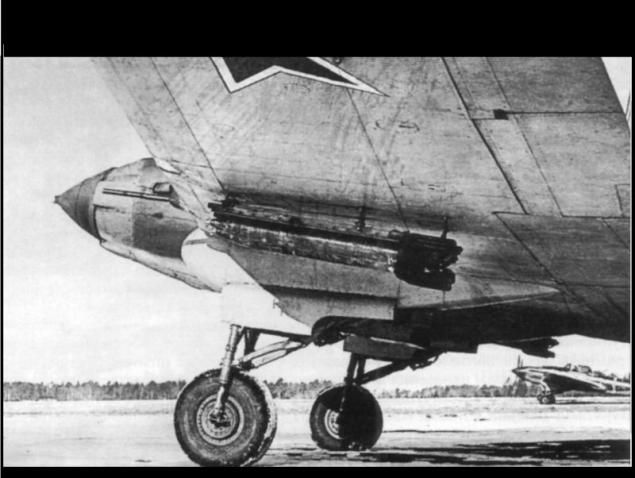
ROFS-132 under the wing of the IL-2
When you break ROFS-132 near the tank at a distance of 1 m from it at an angle of 30 seats in the kinetic energy of the fragments was enough to break through the German tank armor thickness up to 15 mm. At an elevation angle of 60 break ROFS-132 at a distance of 2 meters from the tank provided by shrapnel penetration tank armor thickness of 30 mm.

A direct hit ROFS-132 board, for example, the tank Pz. IV (or the side of the tank destroyer Jgd Pz IV / 70) 30 mm armor-punching, and the equipment and the crew inside the tank, usually disabling. Hit ROFS-132 in the motor part Pz. IV led to the destruction of the tank.
Unfortunately, despite an increase in the accuracy of fire ROFS-132, their effectiveness when shooting at tanks and other armored vehicles in dispersed combat formations to which the Germans went everywhere by this time, was still unsatisfactory. The best results ROFS-132 was given by firing on large area targets - mechanized columns, trains, warehouses, battery field and antiaircraft artillery, etc.
In order to improve anti opportunities simultaneously with the launch of the IL-2 series production, work began on the attack aircraft armament 37mm cannons SHFK-37.
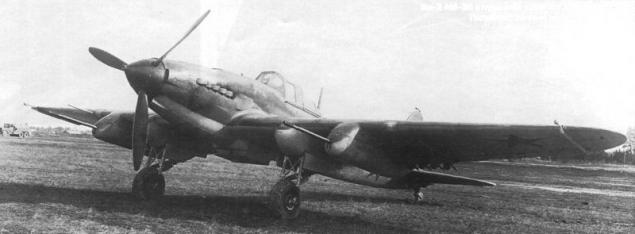
After passing the state test in October 1941, during the second half of 1942 a small series of 10 pieces, was released version of the IL-2 armed with 37mm guns SHFK-37.
37mm aircraft gun SHFK-37 was developed under the leadership of BG Shpitalniy. Weight gun with the installation of the IL-2 was 302, 5 kg. Rate of fire SHFK-37 ground tests according to the average amounted to 169 rounds per minute at a muzzle velocity of about 894 m / s. In gun ammunition includes armor-piercing incendiary tracer (BZT-37) and fragmentation-incendiary tracer (OST-37) missiles.
Projectile BZT-37 provided a breakout of the German tank armor thickness of 30 mm at an angle of 45 degrees. to normal from a distance of not more than 500 m. thick armor of 15-16 mm and smaller projectiles penetrated the meeting at angles less than 60 degrees. at the same distances. Armor thickness of 50 mm (front part of the hull and turret average German tanks) made its way projectile BZT-37 with distances up to 200 m at the corners of the meeting do not exceed 5 degrees.
In this case 51, 5% of heavy ammunition gun SHFK-37 medium tank, and 70% of hits on light tanks disabling them.
Hit 37-mm shells in the rollers, wheels and other chassis parts tanks inflict substantial damage, usually putting out a tank failure.
The report on the range tests guns SHFK-37 on IL-2 highlighted that flight crews must be well trained in the conduct aimed fire in short bursts (2-3 projectile in the queue) small targets such as a separate tank, car, etc . That is the successful use of IL-2 with guns SHFK-37 ground-attack pilot had to have an excellent rifle and flight training.
Large dimensions SHFK-37 guns and nutrition stores (magazine capacity of 40 rounds) identified their location in the fairing under the wing of the IL-2. Due to the installation of a large gun shop it had much lower down relative to the construction plane wing (airplane axis), which not only complicate the design of the gun mount to the wing (the gun was mounted on shock absorbers and by firing moves together with the store), but also required to make She bulky with a large cross-section of the fairing.
Front-line tests have shown that flight data IL-2 with large-caliber cannons SHFK-37, compared with a serial IL-2 with guns ShVAK or load cells markedly decreased. The aircraft became more inert and difficult to pilot technique, especially on bends and turns at low altitude. At high speeds deteriorated maneuverability. The pilots complained of significant load on the handlebars during maneuvers.
Sighting shooting cannons SHFK-37 on IL-2 has been largely hampered due to a strong impact when firing guns and timing differences in their work. Because of the large spacing guns the center of mass of the aircraft, as well as due to insufficient stiffness fastening gun mount, led to the fact that the ground attack by firing experienced strong aftershocks, "peck" and strayed from the line of sight, and this, in turn, given the lack of Buckling "Elah", resulted in a significant dispersion of shells and a sharp decrease (about 4 times) shooting accuracy.
Firing from the same gun was absolutely impossible. Stormtrooper immediately turn towards shooting guns so that a correction in the aim was not possible. Hit the target in this case could only be the first projectile.
At all times during the test gun SHFK-37 does not work reliably - the average percentage nastrela ammunition per one failure, was only 54%. That is, almost every second flight on a combat mission IL-2 with guns SHFK-37 was accompanied by a refusal to at least one of the guns. The maximum bomb load stormtrooper decreased and was only 200 kg. All this greatly reduced the military value of a new attack aircraft. As a result of the installation of guns SHFK-37 on IL-2 in the majority of front pilots did not find support.
Despite the setback with cannons SHFK-37, work to strengthen the arms of IL-2 to continue. First of all, this was due to the fact that in the spring of 1943 only bronetselyami Wehrmacht, that "Elah" still could compete successfully by using cannons, were only lightly armored armored vehicles, armored personnel carriers and self-propelled guns (such as «Wespe», etc. etc.), and anti-self-propelled guns (such as «Marder II» and «Marder III»), created on the basis of light tanks. Actually light tanks as part Panzerwaffe on the Eastern Front had already almost gone. They were superseded by more powerful medium and heavy tanks.
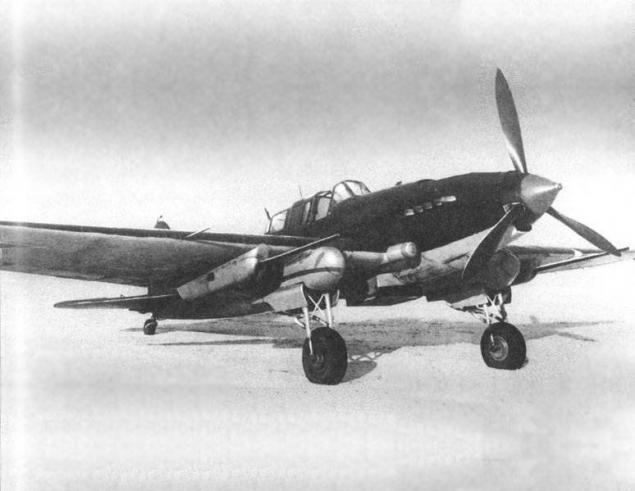
IL-2 armed NA-37
In this regard, in order to improve the properties of anti-attack aircraft of the Red Army GKO decree number 3144 on April 8, 1943 the aircraft factory number 30 pledged to produce double the Il-2 AM-38F with two 37 mm cannons 11 P-37 (HC-37) OKB-16 with ammunition, 50 rounds per gun, no rockets, with a bomb load of 100 kg in the normal version and 200 kg in reloading.
Belt-fed guns NS-37 allowed to place themselves at the lower surface of the wing using structurally very simple and quick mounting. Guns closed relatively small fairings, each of which consisted of two easy to open the valves. Ammunition for each gun fit directly into the compartments of the wing. The weight of one gun NS-37 with ammunition amounted to 256 kg.
Ammunition for the gun NS-37 consisted of cartridges with armor-piercing incendiary tracer (BZT-37) and fragmentation-incendiary tracer (OST-37) missiles. Armor-piercing projectiles designed to defeat armored ground targets, and fragmentation - to destroy air targets. In addition, for the new gun has been designed and subcaliber projectile. Compared with SHFK-37 cannons NS-37 proved to be more reliable and rapid-
July 20, 1943 began which lasted until 16 December combat tests of IL-2 with two 37-mm cannons NS-37. In total, military trials involved 96 Il-2 with NS-37.
The deterioration of the handling characteristics of the new attack aircraft, as well as IL-2 with guns SHFK-37 was associated with a greater spacing of the masses along the wing span and the presence of fairing guns worsening aerodynamics of the aircraft. Throughout the range of CG IL-2 with NS-37 had no longitudinal stability, which significantly reduces accuracy in the air. Last aggravated by the strong impact of guns is fired from them.

Tests have shown that shooting with IL-2 cannons NS-37 must be carried out only in short bursts of no more than two or three shots, as when firing two guns at the same time from timing differences due to their performance aircraft experienced significant pecks and strayed from the line of sight. An amendment to this aim in the case was basically impossible. When shooting a gun hit the target could only be the first shot, as attack aircraft was turning toward shooting guns and amendment aiming to become impossible. The defeat of the same point targets - tanks, armored vehicles, cars etc. during normal operation of the guns was quite achievable.
At the same time entering the tanks were obtained only in 43% of flights and the number of hits to the spent fire unit was 2, 98%.


combat experience during the initial period of the Great Patriotic War showed sufficiently high combat effectiveness of IL-2, with actions to neukrytoy manpower, artillery and mortar positions, trains and convoys.

Mechanized columns of the Il-2 is usually attacked from strafing (altitude approach to the goal of 25-30 meters) along the column or at an angle of 15-20 degrees to its long side. The first blow was struck on the head of the column to suspend its movement. Opening fire range of 500-600 meters. Aiming carried out "in the column at all" with zeroing tracer bullets from machine guns ShKAS. Then, taking into account the position of the track bullets on the objective, opened fire with guns and PC. The effectiveness of on-board fire IL-2 on the objectives that constituted the column (infantry in cars, armored vehicles, artillery, etc.) was high enough.
However, available as part of airborne weapons 20mm cannons ShVAK and 23-mm load cells could only be tackled effectively with light tanks, armored personnel carriers and armored cars.
During the fighting, it became clear that the attack of the German light and medium tanks Il-2, armed with guns ShVAK, along the column completely ineffective because the frontal armor of German tanks had a thickness of 25-50 mm and a projectile gun ShVAK did not break.

Single Il-2 early series, armed with 20-mm cannon and ShVAK 7, 62 mm machine guns ShKAS
Field testing ShVAK gun when firing on captured German tanks carried out between June and 8 July 1942, showed that the armor-piercing shell ShVAK gun can penetrate the armor of chrome-molybdenum steel with high (up to 0, 41%) carbon thickness up to 15 mm (tank Pz .II Ausf F, Pz.38 (t) Ausf C, APC Sd Kfz 250) at angles close to the normal meeting with a distance of no more than 250-300 m. In the event of these conditions is the firing of cannons ShVAK become ineffective.
Thus, by increasing the angle between the projectile with the armor above 40 degrees obtained solid bounce even on sites armor thickness of 6-8 mm. For example, out of 19 results obtained with the shooting of this gun on BTR Sd Kfz 250 (height 400 m approach, glide angle of 30 degrees, the distance of opening fire 400 m), there were 6 of through holes in the board (the thickness of armor 8 mm), 4 - in the roof of the motor hood (thickness 6 mm armor), 3 rebound and 6 hits in the chassis. Hit in the same chassis armored significant lesions are usually not applied.

Destroyed German Sd Kfz 250 armored personnel carrier
Appearance at the front from August 41- th Il-2 with guns VYA- 23 caliber 23 mm although raised in general combat effectiveness assault air units, but not as much as would be desirable - the impact of the modified "sludge" against armored Wehrmacht remained low .
Armor-piercing incendiary projectile 23-mm cannons load cell at a distance of 200 meters past the normal 25-mm armor. IL-2, armed with guns QI-23, could defeat only a slight German tanks, and then only when the last attack from behind or from the side at an angle to the planning of 30 °. Attack as Il-2 of any German tank in front with both planning and a strafing was completely ineffective, and the average German tanks - also when attacking from behind.

According to experienced pilots the most convenient and efficient shooting with IL-2 cannons QI-23 at German tanks, in terms of orientation, maneuvering, the time spent on the combat course, shooting accuracy and so is shooting with planning at an angle 25-30 ° at the input to the planning adjustment 500-700 m and a speed input 240-220 km / h (the height of O - 200-150 m). Gliding speed single IL-2 at these angles increased slightly - only 9-11 m / s, which made possible maneuvering for pickup by the sight and the track. Full Time Attack goal (elimination of side-slip at the turn of the target, aiming and firing of the guns) in this case was ample and varied from 6 to 9 seconds, which allowed the pilot to make two or three turns sights on the basis that to eliminate the side slip stormtrooper at the turn of the target must spend about 1 5/2 seconds, and aiming to fix crosstalk between bursts is also required 1, 5-2 sec, and the queue length is less than 1 s (firing cannons VYa more than 1-2 seconds led to a substantial crosstalk disturbance to a dramatic increase and dispersion of projectiles, i.e. a reduction in accuracy). Range start aiming at the tank is 600-800 m, and the minimum distance of opening fire - about 300-400 m.
In this case, managed to get hit a few shells into the tank. Keep in mind that not all shells in armor-piercing ammunition were. A meeting with the angle of the tank armor was often not optimal for penetration.
Accuracy of missiles RS-82 and RS-132 members of the armed IL-2 allows you to effectively engage area targets, but to fight with tanks, it was clearly insufficient.
Polygon firing rockets regular PC-82 and PC-132 conducted in NPC AB AFRA, as well as the experience of combat use of IL-2 on the front, showed little effectiveness of these weapons by the action of small targets because of the large dispersion of shells and, therefore, low probability of hitting the target.
The average percentage of hits in the RS-82 tank pickup point when shooting from a distance of 400-500 m, as shown in the materials of the report amounted to 1, 1%, and in a column of tanks - 3, 7%, with 186 issued shells were received only 7 direct hits. The height of the approach to the goal - 100 m and 400 m, the angles of planning - 5-10 ° and 30 ", respectively, the range of sight - 800 m. The shooting was carried out by single volley of shells and 2, 4 and 8 rounds.

Missiles RS-82
When firing revealed that the RS-82 can defeat the German light tank type Pz.II Ausf F, Pz.38 (t) Ausf C, as well as an armored car Sd Kfz 250 only when a direct hit.

MS-gap 82 in the vicinity of the tank (0, 5-1 m) no infection it is not harmful. The least probable deviation was obtained in a salvo of 4 RSov planning at an angle of 30 degrees.

RS-82 under the wing of the IL-2
Results firing PC-132 have been worse. Terms attacks were the same as in the RS-82 shooting, but the launch range - 500-600 m. The probable circular deviation range of PC-132 at angles planning IL-2 25-30 degrees approximately 1, 5 times higher than it was, than for the PC-82, and planning for the angles 5-10 degrees - almost coincided.
To destroy light and medium German tank shell PC-132 required only a direct hit, since the bursting shells near the tank, significant damage to the tank, as a rule, did not receive. However, to achieve a direct hit was very, very difficult - of the 134 shots PC-132 made in terms of range pilots with varying degrees of training, do not give any contact with the tank.
Especially for anti-tank aircraft were created with armor-piercing missiles warhead - RBS-82 and RBS-132. Which, in contact with normal punched 50-mm and 75-mm armor respectively. These shells have been created based on the RS-82 and RS-132. In addition to the new warhead, the shells had a more powerful engine, thereby increasing speed flight MS and the probability of hitting the target. As shown by field testing. RBS pierce tank armor and then exploded, causing severe damage inside the tank. RS armor have been successfully applied in the fighting in August 1941. However, mass production of them began only in the second half of the war. Despite the improved performance accuracy and armor penetration, missiles and did not become effective against tanks. Armor penetration is strongly dependent on the angle of the meeting with the armor, and the probability of hitting remained inadequate.
In the arsenal of IL-2, along with rockets RBS-132, had armor-piercing warhead, as a means of combating the German armored vehicles at this time firmly ingrained missile ROFS-132 with improved, compared with the RBS-132 or PC-132, accuracy of fire shooting. Warhead missile ROFS-132 provides through penetration (direct hit), medium armor of German tanks.

ROFS-132 under the wing of the IL-2
When you break ROFS-132 near the tank at a distance of 1 m from it at an angle of 30 seats in the kinetic energy of the fragments was enough to break through the German tank armor thickness up to 15 mm. At an elevation angle of 60 break ROFS-132 at a distance of 2 meters from the tank provided by shrapnel penetration tank armor thickness of 30 mm.

A direct hit ROFS-132 board, for example, the tank Pz. IV (or the side of the tank destroyer Jgd Pz IV / 70) 30 mm armor-punching, and the equipment and the crew inside the tank, usually disabling. Hit ROFS-132 in the motor part Pz. IV led to the destruction of the tank.
Unfortunately, despite an increase in the accuracy of fire ROFS-132, their effectiveness when shooting at tanks and other armored vehicles in dispersed combat formations to which the Germans went everywhere by this time, was still unsatisfactory. The best results ROFS-132 was given by firing on large area targets - mechanized columns, trains, warehouses, battery field and antiaircraft artillery, etc.
In order to improve anti opportunities simultaneously with the launch of the IL-2 series production, work began on the attack aircraft armament 37mm cannons SHFK-37.

After passing the state test in October 1941, during the second half of 1942 a small series of 10 pieces, was released version of the IL-2 armed with 37mm guns SHFK-37.
37mm aircraft gun SHFK-37 was developed under the leadership of BG Shpitalniy. Weight gun with the installation of the IL-2 was 302, 5 kg. Rate of fire SHFK-37 ground tests according to the average amounted to 169 rounds per minute at a muzzle velocity of about 894 m / s. In gun ammunition includes armor-piercing incendiary tracer (BZT-37) and fragmentation-incendiary tracer (OST-37) missiles.
Projectile BZT-37 provided a breakout of the German tank armor thickness of 30 mm at an angle of 45 degrees. to normal from a distance of not more than 500 m. thick armor of 15-16 mm and smaller projectiles penetrated the meeting at angles less than 60 degrees. at the same distances. Armor thickness of 50 mm (front part of the hull and turret average German tanks) made its way projectile BZT-37 with distances up to 200 m at the corners of the meeting do not exceed 5 degrees.
In this case 51, 5% of heavy ammunition gun SHFK-37 medium tank, and 70% of hits on light tanks disabling them.
Hit 37-mm shells in the rollers, wheels and other chassis parts tanks inflict substantial damage, usually putting out a tank failure.
The report on the range tests guns SHFK-37 on IL-2 highlighted that flight crews must be well trained in the conduct aimed fire in short bursts (2-3 projectile in the queue) small targets such as a separate tank, car, etc . That is the successful use of IL-2 with guns SHFK-37 ground-attack pilot had to have an excellent rifle and flight training.
Large dimensions SHFK-37 guns and nutrition stores (magazine capacity of 40 rounds) identified their location in the fairing under the wing of the IL-2. Due to the installation of a large gun shop it had much lower down relative to the construction plane wing (airplane axis), which not only complicate the design of the gun mount to the wing (the gun was mounted on shock absorbers and by firing moves together with the store), but also required to make She bulky with a large cross-section of the fairing.
Front-line tests have shown that flight data IL-2 with large-caliber cannons SHFK-37, compared with a serial IL-2 with guns ShVAK or load cells markedly decreased. The aircraft became more inert and difficult to pilot technique, especially on bends and turns at low altitude. At high speeds deteriorated maneuverability. The pilots complained of significant load on the handlebars during maneuvers.
Sighting shooting cannons SHFK-37 on IL-2 has been largely hampered due to a strong impact when firing guns and timing differences in their work. Because of the large spacing guns the center of mass of the aircraft, as well as due to insufficient stiffness fastening gun mount, led to the fact that the ground attack by firing experienced strong aftershocks, "peck" and strayed from the line of sight, and this, in turn, given the lack of Buckling "Elah", resulted in a significant dispersion of shells and a sharp decrease (about 4 times) shooting accuracy.
Firing from the same gun was absolutely impossible. Stormtrooper immediately turn towards shooting guns so that a correction in the aim was not possible. Hit the target in this case could only be the first projectile.
At all times during the test gun SHFK-37 does not work reliably - the average percentage nastrela ammunition per one failure, was only 54%. That is, almost every second flight on a combat mission IL-2 with guns SHFK-37 was accompanied by a refusal to at least one of the guns. The maximum bomb load stormtrooper decreased and was only 200 kg. All this greatly reduced the military value of a new attack aircraft. As a result of the installation of guns SHFK-37 on IL-2 in the majority of front pilots did not find support.
Despite the setback with cannons SHFK-37, work to strengthen the arms of IL-2 to continue. First of all, this was due to the fact that in the spring of 1943 only bronetselyami Wehrmacht, that "Elah" still could compete successfully by using cannons, were only lightly armored armored vehicles, armored personnel carriers and self-propelled guns (such as «Wespe», etc. etc.), and anti-self-propelled guns (such as «Marder II» and «Marder III»), created on the basis of light tanks. Actually light tanks as part Panzerwaffe on the Eastern Front had already almost gone. They were superseded by more powerful medium and heavy tanks.

IL-2 armed NA-37
In this regard, in order to improve the properties of anti-attack aircraft of the Red Army GKO decree number 3144 on April 8, 1943 the aircraft factory number 30 pledged to produce double the Il-2 AM-38F with two 37 mm cannons 11 P-37 (HC-37) OKB-16 with ammunition, 50 rounds per gun, no rockets, with a bomb load of 100 kg in the normal version and 200 kg in reloading.
Belt-fed guns NS-37 allowed to place themselves at the lower surface of the wing using structurally very simple and quick mounting. Guns closed relatively small fairings, each of which consisted of two easy to open the valves. Ammunition for each gun fit directly into the compartments of the wing. The weight of one gun NS-37 with ammunition amounted to 256 kg.
Ammunition for the gun NS-37 consisted of cartridges with armor-piercing incendiary tracer (BZT-37) and fragmentation-incendiary tracer (OST-37) missiles. Armor-piercing projectiles designed to defeat armored ground targets, and fragmentation - to destroy air targets. In addition, for the new gun has been designed and subcaliber projectile. Compared with SHFK-37 cannons NS-37 proved to be more reliable and rapid-
July 20, 1943 began which lasted until 16 December combat tests of IL-2 with two 37-mm cannons NS-37. In total, military trials involved 96 Il-2 with NS-37.
The deterioration of the handling characteristics of the new attack aircraft, as well as IL-2 with guns SHFK-37 was associated with a greater spacing of the masses along the wing span and the presence of fairing guns worsening aerodynamics of the aircraft. Throughout the range of CG IL-2 with NS-37 had no longitudinal stability, which significantly reduces accuracy in the air. Last aggravated by the strong impact of guns is fired from them.

Tests have shown that shooting with IL-2 cannons NS-37 must be carried out only in short bursts of no more than two or three shots, as when firing two guns at the same time from timing differences due to their performance aircraft experienced significant pecks and strayed from the line of sight. An amendment to this aim in the case was basically impossible. When shooting a gun hit the target could only be the first shot, as attack aircraft was turning toward shooting guns and amendment aiming to become impossible. The defeat of the same point targets - tanks, armored vehicles, cars etc. during normal operation of the guns was quite achievable.
At the same time entering the tanks were obtained only in 43% of flights and the number of hits to the spent fire unit was 2, 98%.








